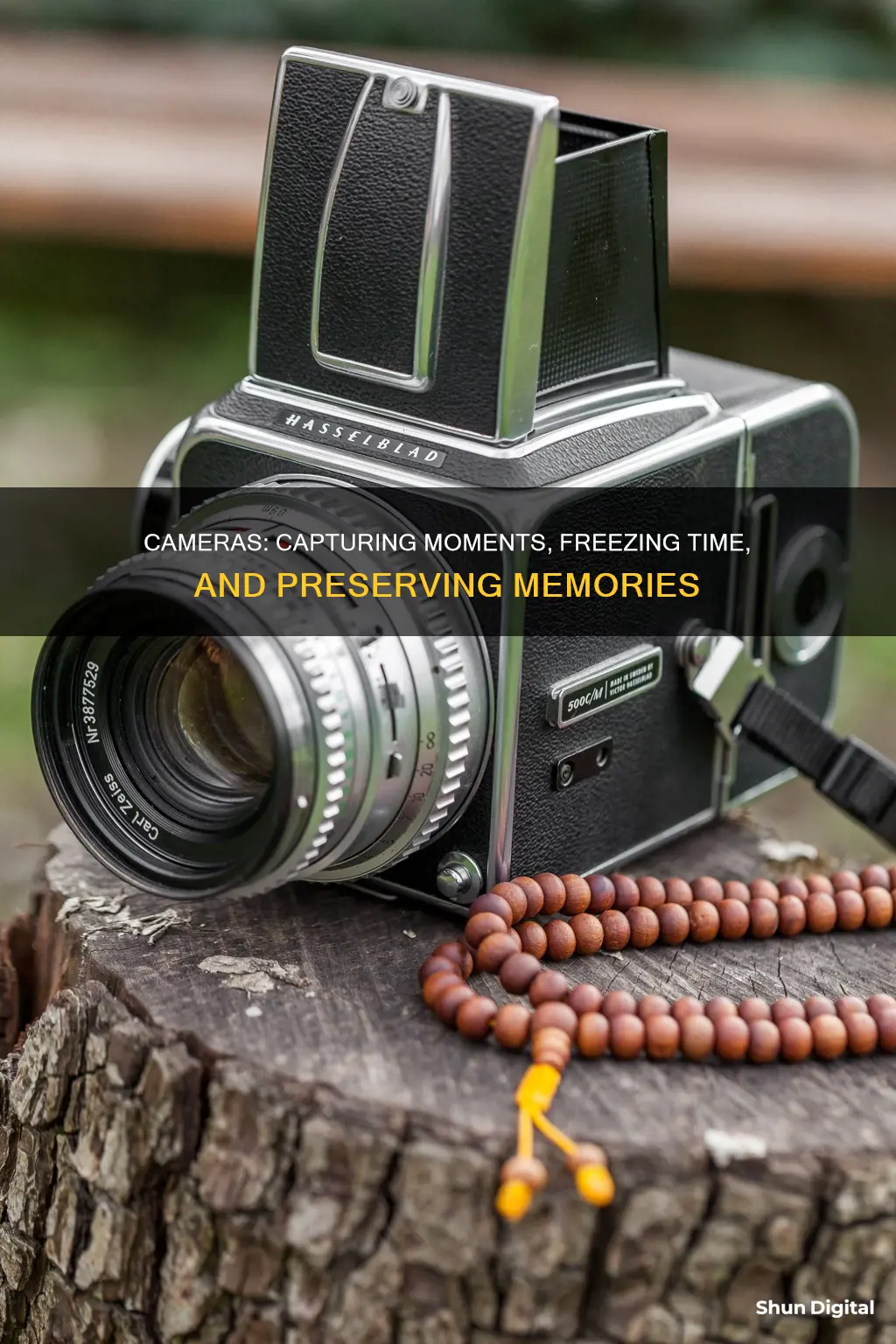
The history of cameras is a long and fascinating one, spanning centuries and involving numerous inventors and innovations. The first cameras, or camera obscuras, were created around 400 BC and were essentially small, dark rooms with a pinhole that projected an inverted image of the outside world onto a wall. Over time, lenses were added to improve image sharpness, and by the 17th century, portable versions of the camera obscura were being used as drawing tools. However, it wasn't until the 19th century that the first permanent photograph was captured by Joseph Nicéphore Niépce, marking the true birth of photography. In the following years, numerous inventors, including Louis Daguerre and William Henry Fox Talbot, contributed to the development of photographic processes and cameras, leading to sharper images, shorter exposure times, and the ability to create multiple prints. The invention of flexible film in the 1880s by George Eastman revolutionized photography once again, making it more accessible to amateurs and paving the way for the iconic Kodak camera and the rise of amateur photography.
| Characteristics | Values |
|---|---|
| Purpose | Capturing and storing images and videos |
| Function | A combination of mechanical components and principles |
| Types | Single-lens reflex (SLR), large-format, medium-format, compact, rangefinder, motion picture, digital |
| Image Storage | Digital (electronic image sensor) or chemical (photographic film) |
What You'll Learn

The camera obscura
By the 16th century, camera obscuras with lenses were being used as drawing aids. In the 17th century, portable versions of the camera obscura were developed, housed in tents and boxes, and used for drawing and painting. The image could be projected onto paper and traced, making it an easy way to achieve proper graphical perspective.
Updating Adobe Camera Raw CS6: A Step-by-Step Guide
You may want to see also

The Daguerreotype camera
The process of creating a daguerreotype image involved polishing a sheet of silver-plated copper to a mirror finish, treating it with fumes to make its surface light-sensitive, and exposing it in a camera for a few seconds to several minutes. The resulting latent image was then made visible by fuming it with mercury vapour and fixed with a chemical treatment to remove its sensitivity to light. Finally, the plate was rinsed, dried, and sealed behind glass in a protective enclosure.
The popularity of the daguerreotype declined in the late 1850s with the introduction of faster and less expensive photographic processes, such as the ambrotype. Despite this, the daguerreotype camera played a significant role in the history of photography, and a small number of photographers have revived the process in recent years for artistic purposes.
Hyperlapse Camera Mode: Capturing Time in a Creative Way
You may want to see also

Roll film cameras
The Kodak cost only $25 and came with the catchy slogan, "You press the button... we do the rest." The Eastman Kodak Company became one of the largest companies in America, with Eastman himself becoming one of the richest men. In 1900, the company created the most simplistic, high-quality camera available to the middle class—The Kodak Brownie. This American box camera was relatively inexpensive, and its accessibility to the middle class helped popularize the use of photography as a way to commemorate birthdays, vacations, and family gatherings. As development costs decreased, people could take photos for any reason, or no reason at all.
The introduction of roll film, along with dry plates, prompted a shift towards smaller and more cost-effective cameras. This period also saw significant advancements in lens technology and the emergence of colour photography, leading to a surge in camera ownership.
Charging the Bdpower Wi-Fi Camera: A Step-by-Step Guide
You may want to see also

35mm film cameras
SLR film cameras, such as the 35mm format, are unique in that they allow you to look straight into the camera's lens to see what you will capture on film. The mirror inside the camera, resting at about 45 degrees from the film, reflects images directly into the viewfinder. When you release the shutter, the mirror flips up according to the speed setting, and the film is protected from exposure. This means you can even switch out lenses mid-shoot without risking overexposing the film.
The first 35mm cameras available to the public were the Tourist Multiple, released in 1913, and the Simplex, released in 1914. However, it was the Leica camera, first designed in 1913, that popularised the use of 35mm film. Its thin and lightweight design, along with the addition of collapsible and detachable lenses, set a new standard and influenced the design of cameras to come.
Today, 35mm film is the most commonly used film in analog photography. It is available in standard cassettes shielding the film from light, as well as in disposable cameras, where the film is encased within the camera body. A standard cassette of 135 film will have 36 exposures available, while later films contained 20 or 12.
Camera B500 Charging: Cable or No Cable?
You may want to see also

The Polaroid camera
The idea for the Polaroid camera came about in 1943, when the company's founder, Edwin Land, was on holiday with his family. Land was taking pictures of his three-year-old daughter, Jennifer, who asked why she couldn't see the photos straight away. At the time, photographs had to be sent away for development, a process that could take several days. Land began to wonder if it was possible to create a camera that could develop photos internally and produce a finished print in a matter of seconds.
The first Polaroid camera, the Model 95, was released in 1948. It produced sepia-toned images and sold out within minutes of its release. The Model 95 required the photographer to time the development of the film, pull out the print to burst a pod of developing chemicals, and peel away the top film. Despite the extra steps, customers loved the idea of instant photography.
In 1950, a true black-and-white version of the Polaroid was released in collaboration with Meroë Morse, an art history major from Smith College. This new film, however, required an extra step in the development process: the developed image had to be manually swabbed with a polymer to prevent it from darkening too much.
Over the next few years, Polaroid continued to refine its instant photography system, improving picture quality and reducing the time needed for development. By 1957, the New York Times called instant photography "equal in tonal range and brilliance to some of the finest prints made by the usual darkroom routine".
In 1963, Polaroid introduced the first instant colour film, Polacolor, which built on the tradition of using three exposures taken through blue, green, and red filters.
In 1972, Polaroid released the SX-70, which represented the culmination of Land's original dream of absolute instant photography. The SX-70 introduced integral print film, which put all the previously manual work inside the camera. Amateur photographers no longer had to peel away layers of film and were instead handed a fully formed photo as soon as it exited the camera.
Despite its success in the instant photography market, Polaroid struggled to keep up with shifting technologies and consumer demands. The emergence of digital cameras in the 1990s dealt a significant blow to the company, and it filed for bankruptcy in 2001. Polaroid has since changed hands several times and continues to produce instant cameras and film, capturing the interest of a new generation nostalgic for antiquated technology.
Charging Your Hover Camera: Battery Basics
You may want to see also
Frequently asked questions
Cameras are used to capture and store images and videos, either digitally or chemically.
There are several types of cameras, each with unique capabilities and suited to specific uses. These include single-lens reflex (SLR) cameras, large-format and medium-format cameras, compact cameras, rangefinder cameras, motion picture cameras, and digital cameras.
A camera is typically made up of three basic elements: an optical element (the lens), a chemical or digital element (the film or sensor), and a mechanical element (the camera body).







